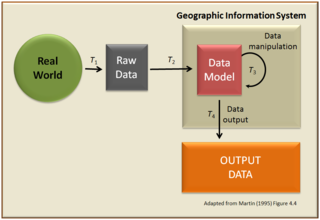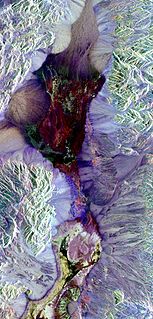
A geographic information system (GIS) is a conceptualized framework that provides the ability to capture and analyze spatial and geographic data. GIS applications are computer-based tools, that allow the user to create interactive queries, analyze spatial information output, edit datum presented within maps, and visually share the results of these operations.

Esri is an international supplier of geographic information system (GIS) software, web GIS and geodatabase management applications. The company is headquartered in Redlands, California.

Remote sensing is the acquisition of information about an object or phenomenon without making physical contact with the object and thus in contrast to on-site observation, especially the Earth. Remote sensing is used in numerous fields, including geography, land surveying and most Earth science disciplines ; it also has military, intelligence, commercial, economic, planning, and humanitarian applications.
Geoinformatics is the science and the technology which develops and uses information science infrastructure to address the problems of geography, cartography, geosciences and related branches of science and engineering.
Spatial network analysis software packages are computer tools used to prepare various graph-based analysis of spatial networks. They stem from various research fields in transportation, architecture and urban planning. The earliest examples of spatial network analysis using computers include the work of Garrison (1962), Kansky (1963), Levin (1964), Harary (1969), Rittel (1967), Tabor (1970) and others in the 1960s and 70s. Various fields of study have later developed specific spatial analysis software to suit their needs, including TransCAD among transportation researchers, GIS among planners and geographers, Axman among Space Syntax researchers, and various plugins for other software platforms. The list below gives and overview of some of the available software. Many of these were developed in academia and are freely available or freely available for academic research.

ArcGIS is a geographic information system (GIS) for working with maps and geographic information maintained by the Environmental Systems Research Institute (Esri). It is used for creating and using maps, compiling geographic data, analyzing mapped information, sharing and discovering geographic information, using maps and geographic information in a range of applications, and managing geographic information in a database.

Spatial analysis or spatial statistics includes any of the formal techniques which studies entities using their topological, geometric, or geographic properties. Spatial analysis includes a variety of techniques, many still in their early development, using different analytic approaches and applied in fields as diverse as astronomy, with its studies of the placement of galaxies in the cosmos, to chip fabrication engineering, with its use of "place and route" algorithms to build complex wiring structures. In a more restricted sense, spatial analysis is the technique applied to structures at the human scale, most notably in the analysis of geographic data.
GIS or Geographic Information Systems has been an important tool in archaeology since the early 1990s. Indeed, archaeologists were early adopters, users, and developers of GIS and GIScience, Geographic Information Science. The combination of GIS and archaeology has been considered a perfect match, since archaeology often involves the study of the spatial dimension of human behavior over time, and all archaeology carries a spatial component.
JTS Topology Suite is an open-source Java software library that provides an object model for Euclidean planar linear geometry together with a set of fundamental geometric functions. JTS is primarily intended to be used as a core component of vector-based geomatics software such as geographical information systems. It can also be used as a general-purpose library providing algorithms in computational geometry.
Participatory GIS (PGIS) is a participatory approach to spatial planning and spatial information and communications management.
Location intelligence (LI), or spatial intelligence, is the process of deriving meaningful insight from geospatial data relationships to solve a particular problem. It involves layering multiple data sets spatially and/or chronologically, for easy reference on a map, and its applications span industries, categories and organizations.
Integrated Land and Water Information System (ILWIS) is a geographic information system (GIS) and remote sensing software for both vector and raster processing. Its features include digitizing, editing, analysis and display of data, and production of quality maps. ILWIS was initially developed and distributed by ITC Enschede in the Netherlands for use by its researchers and students. Since 1 July 2007, it has been released as free software under the terms of the GNU General Public License. Having been used by many students, teachers and researchers for more than two decades, ILWIS is one of the most user-friendly integrated vector and raster software programmes currently available. ILWIS has some very powerful raster analysis modules, a high-precision and flexible vector and point digitizing module, a variety of very practical tools, as well as a great variety of user guides and training modules all available for downloading. The current version is ILWIS 3.8.6. Similar to the GRASS GIS in many respects, ILWIS is currently available natively only on Microsoft Windows. However, a Linux Wine manual has been released.
Hexagon Geospatial's GeoMedia Professional is a geographic information system (GIS) management solution for map generation and the analysis of geographic information with smart tools that capture and edit spatial data. GeoMedia is used for: creating geographic data; managing geospatial databases; joining business data, location intelligence and geographic data together; creating hard and soft-copy maps; conduct analysis in 'real-time'; base platform for multiple applications, geographic data validation, publishing geospatial information and analyzing mapped information.

Geography is a field of science devoted to the study of the lands, features, inhabitants, and phenomena of the Earth and planets. The first person to use the word γεωγραφία was Eratosthenes. Geography is an all-encompassing discipline that seeks an understanding of Earth and its human and natural complexities—not merely where objects are, but also how they have changed and come to be.

A Geographic Information System is a tool for mapping and analyzing data. The ability to layer many features onto the same map and select or unselect as needed allows for a multitude of views and ease of interpreting data. More important, this allows for in depth scientific analysis and problem solving.
Charles Dana Tomlin is an author, professor, and originator of Map Algebra, a vocabulary and conceptual framework for classifying ways to combine map data to produce new maps. Tomlin's teaching and research focus on the development and application of geographic information systems (GIS). He is currently a professor at the University of Pennsylvania School of Design and an adjunct professor at the Yale School of Forestry and Environmental Studies, having also taught at the Harvard Graduate School of Design and the Ohio State University School of Natural Resources. His coursework in Landscape Architecture has extensively included GIS and cartographic modeling applications.
Geosoft Incorporated is a software development and services company headquartered in Toronto, Canada. The company provides geophysical and geological software and geospatial server technology for professional geoscientists involved in natural resource exploration and related earth science disciplines.
Tactician Corporation is a developer and provider of GIS desktop software, SaaS web software, and business intelligence consulting services internationally. The company has its headquarters in Andover, Massachusetts.
GeoMod is a raster-based land change modeling tool in the GIS software TerrSet that simulates the gain or the loss of a land category over a specified time interval. The model only simulates the spatial allocation of change between two land categories either forwards or backwards in time.







